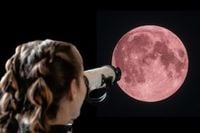The full moon of April is known as the Pink Moon, an astronomical event that captures the attention of skywatchers worldwide. This year, the Pink Moon will reach its peak brightness on the night of Sunday, April 13, 2025, offering a spectacular view for those in Mexico and other parts of the world.
According to journalist Belén Valdehita, the Pink Moon gets its name from the early spring flower phlox subulata, which blooms and blankets fields in the northern hemisphere with a pink hue. Various cultures have their own names for the April full moon; for instance, the Cherokee refer to it as the Flower Moon, while Christians know it as the Paschal Moon or the Egg Moon.
This year, the Pink Moon will coincide with a unique astronomical event: the occultation of Spica, one of the brightest stars in the night sky and a prominent star in the constellation Virgo. This remarkable occurrence will take place on April 12, 2025, in the eastern United States, just a day before the full moon reaches its brightest point.
According to Space.com, the full moon will reach its maximum brightness at 20:22 hours (Eastern Time) on April 12, 2025, which corresponds to 02:22 hours on April 13 in GMT. However, the exact timing of the full moon varies by location. For example, in London, the full moon will be visible at 01:22 hours on April 13, while in Los Angeles, it will occur at 17:22 hours on April 12, before the moon rises in that region.
In New York City, the full moon will become visible at 19:30 hours on April 12, just two minutes before sunset at 19:32 hours. This timing allows residents to enjoy a clear view of the sky for the event. Although observers in New York will not witness the occultation of Spica directly, the moon will appear to pass very close to the star in the night sky. As the moon rises, Spica will be visible to the left of the moon, creating a stunning visual for astronomy enthusiasts.
Interestingly, the term "Pink Moon" does not refer to the color of the moon itself during this phase. Instead, it is rooted in cultural traditions. As noted by Space.com, the name originates from Native American tribes who associated it with the blooming of early spring flowers. Other cultures refer to it as the Hare Moon, the Corn Planting Moon, or the Milk Moon.
One of the most exciting aspects of this year’s Pink Moon will be the occultation of Spica, which will occur just 28 minutes after the full moon reaches its peak. This phenomenon will be visible in several regions, including Central America, South America, and the southernmost coasts of South Africa. During the occultation, the moon will pass in front of Spica, temporarily blocking its light and creating a unique spectacle for observers.
In countries such as Nicaragua, Costa Rica, and Panama, viewers will be able to see Spica disappear behind the moon and then reappear. In other nations, including Colombia, Ecuador, Venezuela, Chile, Bolivia, Paraguay, Argentina, Brazil, and South Africa, spectators will have the opportunity to witness both the disappearance and reappearance of the star. This brief yet captivating event serves as a reminder of the celestial precision with which heavenly bodies align in the cosmos.
As the Pink Moon approaches, enthusiasts are encouraged to find clear locations for optimal viewing. Urban environments with tall buildings and power lines can obstruct the view, so it's wise to seek out open spaces that provide an unobstructed line of sight to the night sky.
The Pink Moon not only represents a time of natural beauty but also a moment for reflection on the cycles of nature and the changing seasons. As spring unfolds, this full moon serves as a reminder of renewal and the vibrant life that accompanies it.
For those eager to experience this astronomical event, mark your calendars for April 12 and 13, 2025. Whether you're in the eastern United States or further afield, the Pink Moon and the occultation of Spica promise to be a breathtaking display in the night sky.



